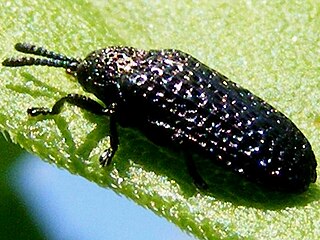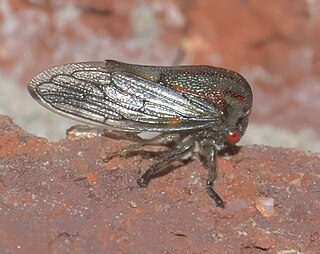
The greater grison is a species of mustelid native to Southern Mexico, Central America, and South America.

Grauer's warbler is a species of Old World warbler in the family Acrocephalidae.

Pteris vittata, commonly known variously as the Chinese brake, Chinese ladder brake, or simply ladder brake, is a fern species in the Pteridoideae subfamily of the Pteridaceae. It is indigenous to Asia, southern Europe, tropical Africa and Australia. The type specimen was collected in China by Pehr Osbeck.

Hakea vittata, commonly known as the striped hakea, hooked needlewood, is a shrub of the family Proteaceae. Restricted to an area on the Eyre Peninsula and the Gawler Range in South Australia and small areas in eastern Victoria.
Dubiraphia vittata is a species of riffle beetle in the family Elmidae. It is found in North America.
Littorophiloscia richardsonae is a species of woodlouse in the family Philosciidae. It is found in North America and Mexico.

Littorophiloscia is a genus of woodlice in the family Philosciidae. There are more than 20 described species in Littorophiloscia.
Coleorozena vittata is a species of case-bearing leaf beetle in the family Chrysomelidae. It is found in Central America and North America.
Aphorista vittata is a species of handsome fungus beetle in the family Endomychidae. It is found in North America and Southern Asia.
Stegana vittata is a species of fruit fly in the family Drosophilidae.

Megetra vittata is a species of blister beetle in the family Meloidae. It is found in North America. Like other blister beetles, megetra vittata excrete cantharidin, a toxic chemical, to defend itself from predators. Animals such as horses can fall ill and die from this toxin as a result of eating many of these beetles, as they have been reported to get mixed in with their hay and other feed.

Megetra is a genus of blister beetles in the family Meloidae. There are at least three described species in Megetra.
Trirhabda pilosa is a species of skeletonizing leaf beetle in the family Chrysomelidae. It is found in North America.

Clastoptera proteus, the dogwood spittlebug, is a species of spittlebug in the family Clastopteridae. It is found in North America.
Eusiphona is a genus of freeloader flies in the family Milichiidae. There are at least four described species in Eusiphona.

Microrhopala vittata, the goldenrod leaf miner, is a species of leaf beetle in the family Chrysomelidae. It is found in North America. Adults emerge in April. Females lay their eggs in clusters of two to four and cover them in frass.

Microrhopala is a genus of tortoise beetles and hispines in the family Chrysomelidae. There are about 18 described species in Microrhopala.

Dacne is a genus of pleasing fungus beetles in the family Erotylidae. There are about 19 described species in Dacne.

The Cuban limia, also known as banded limia, Cuban molly, Cuban topminnow or tabai is a species of livebearing freshwater fish from the family Poeciliidae. The species is native to Cuba where it was endemic but it has been introduced to Hawaii.

Platycotis vittata, the oak treehopper, is a species of treehopper in the family Membracidae, found in North America. The species is also called Platycotis vittatus. It is an oak specialist. Adults protect the nymphs, an example of parental care.












